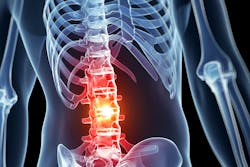Scientists at the University of Michigan wondered if injecting nanoparticles can prevent the body’s immune system from overreacting to trauma, potentially preventing some spinal cord injuries from causing in paralysis.
Turns out they were right, and their approach was demonstrated in mice. The nanoparticles improved healing by reprogramming the aggressive immune cells.
“In this work, we demonstrate that instead of overcoming an immune response, we can co-opt it to promote a therapeutic response,” says Lonnie Shea, a professor of biomedical engineering.
Trauma of any kind kicks the body’s immune response into gear. In normal injuries, immune cells infiltrate the damaged area and clear debris to initiate the regenerative process.
The central nervous system, however, is usually walled off from the rough-and-tumble of immune activity by the blood-brain barrier. A spinal cord injury breaks that barrier, letting in overzealous immune cells that create too much inflammation for delicate neural tissues. That rapidly kills the neurons and damages the insulating sheaths around nerve fibers that let them send signals. It also forms scar tissue that blocks regeneration of the spinal cord’s nerve cells.
All of this contributes to the loss of function below the level of the injury. That spectrum includes everything from total paralysis to a loss of sensation for many of the 12,000 new spinal injury patients each year in the United States.
Previous attempts to offset complications from this immune response included injecting steroids like methylprednisolone. That practice has largely been discarded since it comes with side effects that include sepsis, gastrointestinal bleeding, and blood clots. The risks outweigh the benefits.
But now, University of Michigan researchers have designed nanoparticles that intercept immune cells on their way to the spinal cord, redirecting them away from the injury. And those that reach the spinal cord have been altered to be more pro-regenerative.
With no drugs attached, the nanoparticles reprogram the immune cells with their physical characteristics: a size similar to cell debris and a negative charge that facilitates binding to immune cells. In theory, their nonpharmaceutical nature avoids unwanted side effects.
With fewer immune cells at the trauma location, there is less inflammation and tissue deterioration. Second, immune cells that do make it to the injury are less inflammatory and more suited to supporting tissues that are trying to grow back together.
“Hopefully, this technology could lead to new therapeutic strategies not only for patients with spinal cord injury but for those with various inflammatory diseases,” says University of Michigan researcher Jonghyuck Park.
Previous research has shown that nanoparticles have successfully mitigated trauma caused by the West Nile virus and multiple sclerosis, for example.
“The immune system underlies autoimmune disease, cancer, trauma, regeneration, nearly every major disease,” Shea says. “Tools that target immune cells and reprogram them to a desired response have numerous opportunities for treating or managing disease.”

